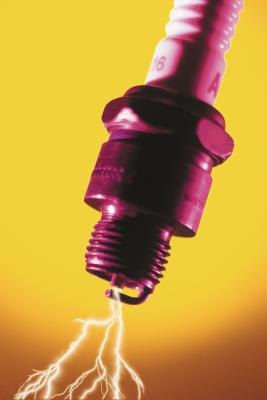Wednesday, April 16, 2014
What Instrument Is Used to Test the Condition of a Spark Plug

While the computerized engine management systems that run todays cars are extremely complex and require increasing specialized diagnostic equipment and tools, all gasoline-burning engines must still have spark plugs. The plugs allow a properly timed spark of electricity to jump through the flammable mixture introduced into the top of the piston chamber, causing ignition. Ascertaining their condition is done more through familiarity and interpretive knowledge than through the use of a single piece of equipment.
Know Your Plugs
The terms cold plug and hot plug are often used, and a knowledge of what to expect from the plug is necessary in determining its condition. The terms er to the ability of the material that the plug is made from to transfer heat, in this instance from the point at which the spark occurs into the engine block for dissipation. A cold plug transfers heat quickly and does not work well at extremely high temperatures. A hot plug transfers heat poorly, allowing heat to build up to approximately 1,550 degrees Fahrenheit, and is designed to work in that way; hot plugs are less susceptible to fouling because they burn off contamination. Identification is a question of experience: In general, hot plugs have longer insulator tips.
Visual Condition
Always allow an engine to fully cool before attempting any service work, including the removal of spark plugs. If the insulator tip of a plug that has been in service looks pale gray, or pale gray with a yellow or brown tint, the engine is running correctly, the spark plug gap is set correctly and the plug is torqued correctly into the receiver. Dull, black carbonization on the tip suggests that too-cold plugs are in use, and they should be replaced with hotter-running units. As with all visual indications, this symptom could also indicate problems elsewhere in the engine, in this instance a bad fuel mixture. Melting at the electrode indicates either that the plug was incorrectly torqued into position or that the heat range of the plug is not as suggested for the engine.
Gapping
The space between the electrode and the insulator tip must be exact for the plug to function correctly. Spark plug gap-testing tools are a set of wafer-thin blades -- each blade looks something like a fingernail cleaner -- that rotate on a pivot in and out of a case. These tools used to be ubiquitous in every do-it-yourselfers and professionals kit, but modern engines and plug technology have made them all but redundant. New plugs are now delivered with the gap precisely set and do not deform under any but the most extreme of engine conditions. If a modern spark plug gap changes under use, that is a symptom, not a cause; the cause must be determined by engine diagnostics and the plug set replaced after rectification of the fault.
Equipment
An array of equipment is available to test spark plug condition, but the visual checks suggested and a regular maintenance schedule make the investment practically unnecessary, even for the professional. The spark plug gapping tool is, as noted, all but redundant in modern vehicle maintenance practices. Working according to the manufacturers instructions, it is possible to use a volt-ohmmeter to ascertain the circuit load.
Voltage Testing
Metered spark gap testers are available that plug into the coil to measure the jump of the spark. Capable of handling current between 0 and 40,000 volts, the tool diagnoses faults in the coil, the ignition wires and the plugs.
Testing Spark Plug Wires
Inline spark testers that use a bulb do not give a metered reading, but they do give an instant indication of whether a coil-wire-plug circuit is operational. The device is inserted between the plug and the wire, after you have first removed the wire from the top of the plug. When the engine is turned over a bulb flashes if the circuit is functional but does not flash if it is faulty. Compact ignition testers are extremely simple to use to verify that there is a spark to the plug. Fitted into a plug wire end and clamped to the engine, they should spark when the engine is turned over. If they do not, there is a problem upstream of the device.